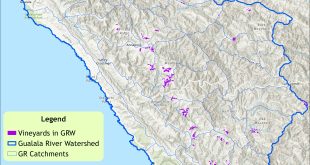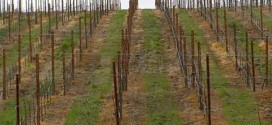Vineyard Conversion at
Pomo Heritage Land in Annapolis
Erasing Forests & History?
by Peter Baye
Friends of the Gualala River
| A version of this article was published in the Sonoma County Gazette October, 2010 |
Sonoma County residents are familiar with environmental impacts of vineyard conversions, but the Artesa project proposed by Codorniu Napa’s Artesa winery adds a new cultural dimension.
Another Forest-to-Vineyard Conversion in Annapolis?
CAL FIRE (formerly California Department of Fire Protection and Forestry, CDF) is deciding whether to authorize conversion of 171 acres of mixed redwood forest on a 324 acre site in Annapolis (unincorporated northwestern Sonoma County) to construct a 130-acre vineyard for premier wine grapes. Extensive vineyards already cover many of the gently sloping ridgetops where meadows of sheep ranches, orchards, and mixed redwood forests formerly covered the landscape. The Artesa “Fairfax” vineyard project is the second largest pending vineyard conversion in Annapolis, exceeded only by the unprecedented nearly 1,700 acre “Preservation Ranch” conversion.
Kashaya Heritage Threatened
Convergent evidence points to the very real possibility “that the Artesa property or Fairfax Conversion is located in the midst of a significant complex of Native American archaeological sites,” according to Dr. Peter Schmidt, a professor of anthropology and professional archaeologist. The draft EIR states that the vineyard project area is “very possibly the Kashaya Pomo village Kabatui” where “human remains may be present,” and which contains rich archaeological areas that are eligible for listing in the National Registry of Historic Places and the California Registry of Historic Places.
More Than Just a Watershed
The mission of Friends of the Gualala River (FoGR) is focused on the ecological integrity of the Gualala River and its watershed, but we have learned that the deep, ancient cultural resources of this watershed are inextricably linked to its ecology. Protecting the flows, fish, forests, and wildlife of the watershed cannot be separated from the people who lived with and shaped the watershed for millennia.
FoGR’s vision is to convince the current landowner, the large and very old Spanish corporation Codorniu (owner of the Artesa Napa wine label) to withdraw the project at this site, and convey the land to either a land trust or other conservancy dedicated to protection of the site’s environmental and cultural resources. This land can and should be managed to provide a cultural (and possibly also economic and employment) resource to the local resident Kashia tribal members, while offering protection for salmon, steelhead, wildlife, and forest plants used by the Kashia. Even better if compatible public access and public or nonprofit ownership could bring a core visitor destination to Annapolis, and local economic benefits typical of communities surrounding county or state parks.
History of Inadequate CEQA – “No Impact”
How did this vineyard project progress through seven years of permit review and an EIR process while located on such an extraordinary location of archaeological and cultural significance?
In CDF’s July 10, 2002 California Environmental Quality Act (CEQA) “environmental checklist” prepared for pre-timber harvest inspection of Artesa site timber, CDF checked the box for “no impact” to significant cultural/historic resources that are either listed or eligible for listing under the national or California registers of historic places. The check-box for “disturb any human remains…” was also checked “no impact.” At that time, the first of several archaeological studies had been prepared for the project site as part of the environmental review process. Not only were no alarms raised for potential significant impacts, the initial study for the project affirmed that there were simply no impacts at all to significant cultural or archaeological resources.
Soon afterward, Friends of the Gualala River (FoGR) challenged the Artesa timber harvest and conversion plans, citing major deficiencies and flaws in their environmental assessments. FoGR submitted evidence from scientific experts that the project would result in “significant” physical and biological impacts to the watershed and river that trigger the full Environmental Impact Report (EIR) process. FoGR attorney Paul Carroll filed CEQA lawsuits against CDF for failing to require EIRs for other forest conversions for vineyard projects in Annapolis. FoGR prevailed in those legal precedents, and in September 2004, CDF initiated the scoping process for an EIR on Artesa’s “Fairfax” conversion in Annapolis. Then the EIR process mysteriously left public sight for over four years – an extraordinary delay in preparing an EIR.
When the draft EIR finally appeared in May 2009, it contained a very different assessment of archaeological resources in the Artesa project area. Two separate archaeological experts were brought in to assess and re-assess new findings of multiple archaeological sites. The EIR determined that multiple individual archeological sites within the project area, some of which contained “specimens between 5000 and 7000 years old,” were eligible for inclusion in national and state registers of historic places.
Professor Schmidt reviewed the EIR, and concluded that the sampling methods were deficient, and failed to incorporate of key evidence about the Kashaya Pomo village locations documented in 1908 by Samuel Barrett, a University of California Berkeley anthropologist who studied the Pomo in great detail. Schmidt identified “failure to conduct a rigorous scientific assessment of heritage resources on the Artesa property.”
Mitigation?
CAL FIRE’s official “mitigation” for protecting known significant archeological [sites] in the project area was to build the vineyard around the boundaries of individual areas determined to be eligible for national and state listing as historic places/resources. Its approach to mitigating impacts to yet-undiscovered Pomo artifacts or human remains was to have the operators of earth-moving equipment stop and report to experts if they see any human bones or artifacts being unearthed as they deep-rip the soils after clear-cutting of the forest. In his letter to CAL FIRE, Dr. Schmidt criticized these mitigation protocols as inadequate, and argued that monitoring alone, without rigorous and systemic surveys, “poses high risk to sub-surface archaeological resources.” He also questioned whether equipment operators were sufficiently motivated and capable of detecting small archaeological specimens during disturbances of earth-moving operations.
What Happens Next?
During the comment period of the draft EIR in 2009, Annapolis residents observed additional archaeological field survey vehicles and crews working on the site. As of this date (September 2010), no final EIR has been issued, and CAL FIRE has reportedly been considering re-circulating a limited or “focused” draft EIR with revised treatment of cultural and historic resources. Both the final EIR or a possible recirculated draft EIR will be open to public comments and review by qualified experts.
It is uncertain whether the emerging discovery and understanding of the apparent Pomo village and camp site complex within the proposed Artesa vineyard area will be enough to prevent the project from being permitted. FoGR anticipates that public education and appropriate participation in the permit process could lead the way to protection of these threatened lands and waters, and a more suitable alternative location for yet another vineyard.

Peter Baye, Ph.D., is a botanist and
coastal plant ecologist who lives in Annapolis.
For additional information, see:
 Pomo elders speak out about vineyards
Pomo elders speak out about vineyards
Where we used to live, no one can see anything now. It is time we open our mouths. Those vineyard people are interfering with our ancestors’ area…
 Erasing Native American history?
Erasing Native American history?
As an early morning mist filters through the Redwoods in the village of Annapolis in NW Sonoma County, a Pomo elder of the Kashia band walks through the forest toward an ancient settlement site…
 Desecration of Pomo history
Desecration of Pomo history
A first step toward satisfying the responsibility for Europeans and their descendants in North America would be to treat indigenous people with respect.
Artesa (“Fairfax”) vineyard conversion EIR CAL FIRE released the Final Environmental Impact Report (EIR) for Artesa Winery’s plan to clear-cut 154 acres of coastal redwood forest to plant a vineyard in Annapolis. The EIR states that the project will have no significant environmental or cultural impacts.
CAL FIRE released the Final Environmental Impact Report (EIR) for Artesa Winery’s plan to clear-cut 154 acres of coastal redwood forest to plant a vineyard in Annapolis. The EIR states that the project will have no significant environmental or cultural impacts.
 Friends of Gualala River Protecting the Gualala River watershed and the species living within it
Friends of Gualala River Protecting the Gualala River watershed and the species living within it


